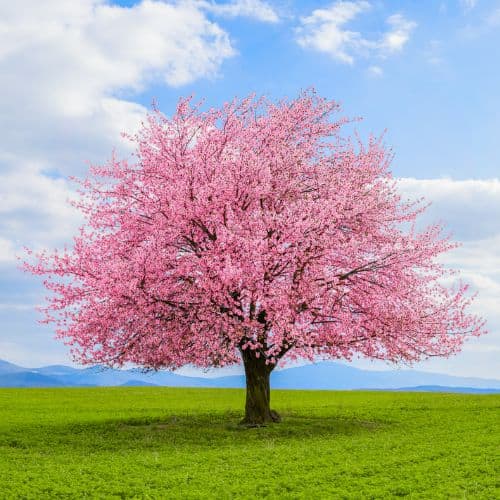Cherry Trees, belonging to the genus Prunus, have a rich history that spans centuries and a remarkable presence in gardens worldwide. These trees are known for their fruit, blossoms, and practical uses for shade or as a focal point in the garden. Originating from Asia, Cherries were introduced to Europe through the Silk Road, and their cultivation spread across the continent.

Growing and Caring for Cherry Trees
Most Cherry trees prefer well-drained soil that is rich in organic matter. While they can tolerate a range of soil types, they thrive in slightly acidic to neutral pH. Adequate sunlight is crucial for flowering and fruiting, so planting cherry trees in a location with full sun exposure is advisable.
Cherry trees are susceptible to certain pests and diseases, such as aphids, caterpillars, and fungal infections. Regular monitoring and appropriate pest control measures, including horticultural oils or insecticidal soaps, can help maintain the tree’s health. Adequate spacing between trees promotes air circulation, reducing the risk of fungal diseases.
Proper watering is essential to support healthy growth and fruit development, particularly during dry periods. Mulching around the tree’s base helps retain soil moisture and suppress weeds. Additionally, applying a balanced fertilizer in early spring provides the nutrients for robust foliage and fruitful harvests.
Uses In Gardening & Landscaping
Fruiting cherry trees offer the added benefit of delicious and versatile fruit. Sweet cherries are enjoyed fresh, while sour cherries are commonly used in baking, preserves, and culinary applications. The fruiting varieties, such as Bing and Rainier for sweet cherries and Montmorency for sour cherries, can be incorporated into orchards or home gardens to provide a bountiful harvest.
Ornamental cherry varieties, such as the popular Yoshino cherry (Prunus x yedoensis), are widely used to enhance the aesthetic appeal of gardens, parks, and streetscapes. Their breathtaking spring blossoms, from delicate whites to vibrant pinks, create a stunning visual display. Cherry trees also serve as effective shade trees, providing cooling shade during summer. Their broad canopies create inviting outdoor spaces for relaxation and socializing. Additionally, cherries are often used as specimen trees, focal points in garden design that draw attention and create a sense of balance and harmony.

Size and Shape
Cherry trees exhibit a wide range of sizes and shapes. Generally, they can be classified into two main types: ornamental cherries (Prunus serrulata) and fruiting cherries (Prunus avium and Prunus cerasus). Ornamental cherry trees often have a more graceful, vase-shaped form, emphasizing their stunning blossoms. They are typically smaller, ranging from 15 to 25 feet tall.
As for Fruiting Cherry trees, standard-sized sweet cherry trees (Prunus avium) can reach heights of 25 to 35 feet, while sour cherry trees (Prunus cerasus) are generally more compact, reaching heights of 15 to 20 feet. Additionally, there are dwarf and semi-dwarf varieties that are suitable for smaller gardens or container planting.
Leaves and Branches
Cherry tree leaves are simple, alternately arranged, and vary slightly in shape depending on the species. They are typically elliptical with serrated edges, showcasing a vibrant green color during the growing season. In the fall, the foliage often transforms into stunning shades of red, orange, or yellow, adding a final burst of color to the landscape before winter.
Cherry tree branches are an essential part of their aesthetic appeal. Ornamental cherry varieties often have elegant, spreading branches that create a picturesque silhouette. In contrast, fruiting cherry trees develop a more robust framework to support the weight of the fruit. Pruning is essential for maintaining a healthy structure, promoting air circulation, and enhancing the tree’s overall appearance.

Frequently Asked Questions
When Is The Best Time To Plant Cherry Trees?
The ideal time to plant cherry trees is in late fall when the tree is dormant. Planting during these periods allows the tree to establish its roots before the onset of active growth.
How Do I Prune Cherry Trees?
Pruning is crucial for maintaining the health and shape of cherry trees. Prune during late winter or early spring before new growth begins. Remove dead or diseased branches and thin out crowded areas to improve air circulation. Additionally, prune to shape the tree and encourage a strong framework.
Do Cherry Trees Require Cross-Pollination?
Some cherry varieties, especially sweet cherries, benefit from cross-pollination for optimal fruit sets. Planting two or more compatible cherry trees nearby is advisable to ensure adequate pollination.
How Do I Protect Cherry Blossoms From Late Frosts?
Late spring frosts can damage cherry blossoms. Covering the tree with a frost cloth or sheet during frost warnings can help protect the delicate blossoms from cold temperatures.
